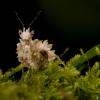Edited by MegaMyrmex, December 5 2017 - 2:58 PM.
- Formiculture.com
- Forums
- Gallery
- Members
- Member Map
- Chat

Edited by MegaMyrmex, December 5 2017 - 2:58 PM.
Proverbs 6:6-8 New International Version (NIV)
6 Go to the ant, you sluggard;
consider its ways and be wise!
7 It has no commander,
no overseer or ruler,
8 yet it stores its provisions in summer
and gathers its food at harvest.
Cryptocercus is a nearly impossible to raise genus. I would recommend Parcoblatta, I keep seven Parcoblatta pennsylvanica nymphs as desktop pets. They eat fish food, apples, carrots, dog food, honey, sugar water, and nearly everything else you'd expect a pet roach to eat.
I find large groups of Parcoblatta nymphs under logs (hibernating) They only need to hibernate for a month to do well.
You can also find large (1 inch) adults in the spring, while they travel to look for mates. They are fun to breed, and the hatchling nymphs are tiny!
All stages of this species can't climb up smooth surfaces. They still enjoy climbing, so I would recommend adding a twig or branch to their setup to climb on.
Proverbs 6:6-8 New International Version (NIV)
6 Go to the ant, you sluggard;
consider its ways and be wise!
7 It has no commander,
no overseer or ruler,
8 yet it stores its provisions in summer
and gathers its food at harvest.
Trust me, they're everywhere in the spring. The adults are so pretty, though!
0 members, 0 guests, 0 anonymous users